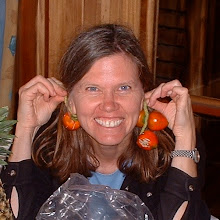This past weekend we went to Cerro de la Muerte in southern Costa Rica. Many tourists wrongly assume the highest mountain pass on the Inter-American Highway is called the mountain of death because of the condition of the road. The road is quite good now and the name comes from earlier times when people walked or rode horses from their hot, lowland homes and sometimes died from hypothermia in the mountains when they over-nighted at chilly high elevations. Fortunately, just before we pulled out of the driveway I decided to run back into the house and grab a wool stocking cap and gloves which I ended up wearing most of the time. We were birding at elevations of 2200-3640 meters (7218-11,942 feet). Even in the tropics it is cold up that high.
My "target bird" — the one I most wanted to see on this trip—was the Long-tailed Silky Flycatcher. I don't know how we missed it on our other trip to this area, because it was almost the first bird we saw when we got out of the car and we saw it very frequently for the entire 5 day trip.
Sometimes birds were hard to see due to fog. This was the way it looked when I saw my first Silky. There's a reason they call them cloud forests.
We stayed at Savegre Hotel in San Gerardo de Dota and were extremely pleased with our cabin, the food, and the extensive trail system. The primary cloud forest above the lodge is made up of mostly oaks but if you are used to oak forests in the U.S., you will find they look very different in the tropics. Notice that it can be sunny in the cloud forest.
Tropical trees often don't have branches until an incredible height and this tree was so tall I couldn't get any of its branches in the photo. This particular Quercus bumelioides was named tree of the year in 2010 by InBio, Costa Rica's National Institute for Biodiversity.
Many people go to San Gerardo de Dota to see the Resplendent Quetzal. We saw quite of few and enjoyed seeing them fly high above us. Easier photo subjects were the wonderfully comical Acorn Woodpeckers that come to the lodge's garden to eat bananas at the feeder.
We were amused by how these Sulfur-winged Parakeets liked to sit so close to each other.
Continuing the humor theme, check out the "beard" on this ferocious little ball of fluff. He's the Talamancan version of the Volcano Hummingbird, one of the smaller hummingbirds in Costa Rica. It's hard to believe that such a tiny bird can live in the cold páramo above the elevation where forests can grow.
My "target bird" — the one I most wanted to see on this trip—was the Long-tailed Silky Flycatcher. I don't know how we missed it on our other trip to this area, because it was almost the first bird we saw when we got out of the car and we saw it very frequently for the entire 5 day trip.
Sometimes birds were hard to see due to fog. This was the way it looked when I saw my first Silky. There's a reason they call them cloud forests.
We stayed at Savegre Hotel in San Gerardo de Dota and were extremely pleased with our cabin, the food, and the extensive trail system. The primary cloud forest above the lodge is made up of mostly oaks but if you are used to oak forests in the U.S., you will find they look very different in the tropics. Notice that it can be sunny in the cloud forest.
Tropical trees often don't have branches until an incredible height and this tree was so tall I couldn't get any of its branches in the photo. This particular Quercus bumelioides was named tree of the year in 2010 by InBio, Costa Rica's National Institute for Biodiversity.
Many people go to San Gerardo de Dota to see the Resplendent Quetzal. We saw quite of few and enjoyed seeing them fly high above us. Easier photo subjects were the wonderfully comical Acorn Woodpeckers that come to the lodge's garden to eat bananas at the feeder.
We were amused by how these Sulfur-winged Parakeets liked to sit so close to each other.













1 comment:
joy joy joy.
having your adventure vicariously through you and your blog.
Post a Comment